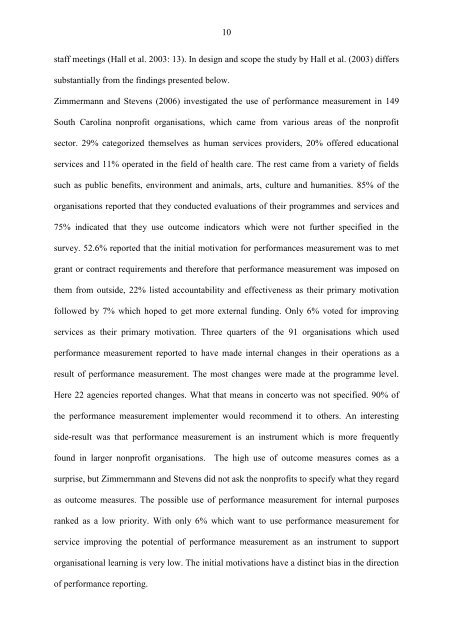Strategic responses to Performance Measurement in Nonprofit ...
Strategic responses to Performance Measurement in Nonprofit ...
Strategic responses to Performance Measurement in Nonprofit ...
Create successful ePaper yourself
Turn your PDF publications into a flip-book with our unique Google optimized e-Paper software.
10<br />
staff meet<strong>in</strong>gs (Hall et al. 2003: 13). In design and scope the study by Hall et al. (2003) differs<br />
substantially from the f<strong>in</strong>d<strong>in</strong>gs presented below.<br />
Zimmermann and Stevens (2006) <strong>in</strong>vestigated the use of performance measurement <strong>in</strong> 149<br />
South Carol<strong>in</strong>a nonprofit organisations, which came from various areas of the nonprofit<br />
sec<strong>to</strong>r. 29% categorized themselves as human services providers, 20% offered educational<br />
services and 11% operated <strong>in</strong> the field of health care. The rest came from a variety of fields<br />
such as public benefits, environment and animals, arts, culture and humanities. 85% of the<br />
organisations reported that they conducted evaluations of their programmes and services and<br />
75% <strong>in</strong>dicated that they use outcome <strong>in</strong>dica<strong>to</strong>rs which were not further specified <strong>in</strong> the<br />
survey. 52.6% reported that the <strong>in</strong>itial motivation for performances measurement was <strong>to</strong> met<br />
grant or contract requirements and therefore that performance measurement was imposed on<br />
them from outside, 22% listed accountability and effectiveness as their primary motivation<br />
followed by 7% which hoped <strong>to</strong> get more external fund<strong>in</strong>g. Only 6% voted for improv<strong>in</strong>g<br />
services as their primary motivation. Three quarters of the 91 organisations which used<br />
performance measurement reported <strong>to</strong> have made <strong>in</strong>ternal changes <strong>in</strong> their operations as a<br />
result of performance measurement. The most changes were made at the programme level.<br />
Here 22 agencies reported changes. What that means <strong>in</strong> concer<strong>to</strong> was not specified. 90% of<br />
the performance measurement implementer would recommend it <strong>to</strong> others. An <strong>in</strong>terest<strong>in</strong>g<br />
side-result was that performance measurement is an <strong>in</strong>strument which is more frequently<br />
found <strong>in</strong> larger nonprofit organisations. The high use of outcome measures comes as a<br />
surprise, but Zimmernmann and Stevens did not ask the nonprofits <strong>to</strong> specify what they regard<br />
as outcome measures. The possible use of performance measurement for <strong>in</strong>ternal purposes<br />
ranked as a low priority. With only 6% which want <strong>to</strong> use performance measurement for<br />
service improv<strong>in</strong>g the potential of performance measurement as an <strong>in</strong>strument <strong>to</strong> support<br />
organisational learn<strong>in</strong>g is very low. The <strong>in</strong>itial motivations have a dist<strong>in</strong>ct bias <strong>in</strong> the direction<br />
of performance report<strong>in</strong>g.
















